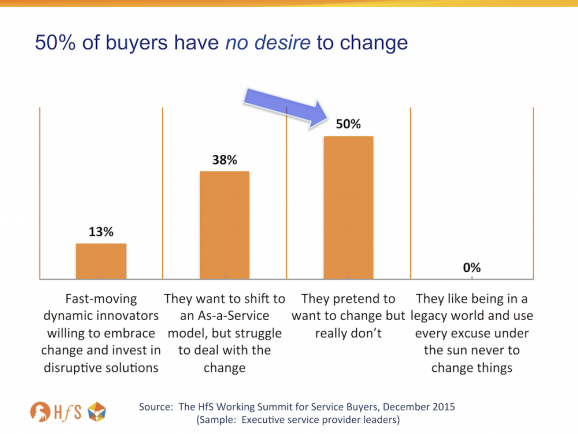 If you haven’t been bored silly listening to all the rampant change we are about to endure from literally every information outlet (and we are also complicit), then this data point from our recent Harvard Buyers Summit will open your eyes. Simply put, when we anonymously polled the service provider leaders in the room on what they really thought about buyers, half of them view them as only pretending they welcome change, and don’t really want to:
If you haven’t been bored silly listening to all the rampant change we are about to endure from literally every information outlet (and we are also complicit), then this data point from our recent Harvard Buyers Summit will open your eyes. Simply put, when we anonymously polled the service provider leaders in the room on what they really thought about buyers, half of them view them as only pretending they welcome change, and don’t really want to:
On the positive side, 50% do want to change, but most struggle, but the fact that so many are only paying lip service to their peers, colleagues and service partners is a real issue. How can you effectively target clients you can grow with as a provider, if you can’t really trust the intentions of half your clients? And how can you drive initiatives as a buyer, when most your colleagues really do not have any interest?
The Bottom-line: You must weed out the change imposters if you don’t want to go down with them, or find another employer who promotes change
Smart consultants and practitioners are those who can quickly read their colleagues to find out if they genuinely are prepared to do things differently – and make real efforts to learn new methods and create new ideas. And this is really done through the legacy old school techniques of developing close relationships. You’ll learn more about someone’s attitude and approach over a few drinks or a nice dinner than sharing big words and corporate pleasantries in a boardroom.
Your skills to collaborate and engage with people is critical in identifying where people need to change, and how we can all improve as a team. This is where methods like Design Thinking are so important – there is little hiding from initiatives where the outcomes are clearly defined, prioritized and an execution plan is put in place. If people really do not want to embrace change, then they can’t hide forever, and clearly many are in this camp. However, if you surround yourself with unambitious people, they will eventually throw you off their sinking ship to save themselves…
Alternatively, if your company is fully laden with change-imposters and there’s no simple way to avoid them, despite your best efforts, then get out of there now. You owe nothing to an employer unwilling to foster change and encourage innovation, and there is such a talent shortage in industry these days, you’ll find plenty of firms willing to take you on with your attitude…
Posted in : 2015 HfS Buyers Summit, Business Process Outsourcing (BPO), Design Thinking, HfSResearch.com Homepage, HR Strategy, Social Networking, sourcing-change, Talent in Sourcing, The As-a-Service Economy








Suppliers think that buyers are imposters – “don’t mean what they say” – 50%
Buyers think that suppliers are less competent – “we have to direct them” – 69%
Surveys were anonymous but I wonder if majority of these statements are overlapping. Signalling a serious trust deficit.
Phil, Durgesh, Would you say the challenge is simply because service provider reps are unable to identify the possible early adopter clients and secondly, unable to put together a workable plan for the change path for such clients in a manner that fits them (than fits the service providers)?
I know you have written elsewhere about the need to create a target set of clients in specific verticals etc. and then cannibalizing/transforming in their landscape but it appears that is not happening, yet?
Why talk about trust, when all you got to do is put a clear proposition on the table and ask to go implement? The clients that want to change will be happy to collaborate on that journey?
Valid questions Manish.
I take your point about provider not able to put together a clear plan more often than not.
But the other side of the issue is that in client organisation, although the top layer (CXOs) might be genuinely interested to collaborate, the middle managers don’t want to completely let go the control, hence the perception of imposters and lack of trust.
Yes and perhaps the challenge is that despite what the various vendors (Oracle, MS Azure, IBM etc.) or service providers offer up, the solution is complicated for middle management IT when you consider the specifics and what they deal with on a daily basis. Maybe it is defensive too or whatever but managing an as a service environment across on-premises hosted, private cloud, public services cloud (IaaS/SaaS etc.) is unchartered territory for many. Perhaps the second bucket (38%?) is really where most are at, maybe 50% is a bit overstated…
The middle layer of-course knows that running in-house/hosted data centers and apps the old way, that managing the various trivial repetitive tasks with resources for the regular admin of assets is not going to be the way things will work forever.
Coming to the service providers targeting these buyers, on second thought, perhaps the early adopters (13%?) by definition are self starters and likely to do and run things themselves. The may not jump at the service provider value yet, its the early majority that is where the battle will be played out – service providers that get the act there will sustain. There is a lot of talk of finding that majority in the upper middle market clients, not the very large enterprises?
Perhaps it’s because the change in the wind that’s coming, is actually now really starting to effect the buyers themselves… Ever pondered that? It’s really for the “C” suite to be more proactive to ensure the wool isn’t being pulled over ones eyes”…
So, perhaps imposters is one word but I could think of a few others; “scared”, “protectionism”, “Do nothing is safest”…..